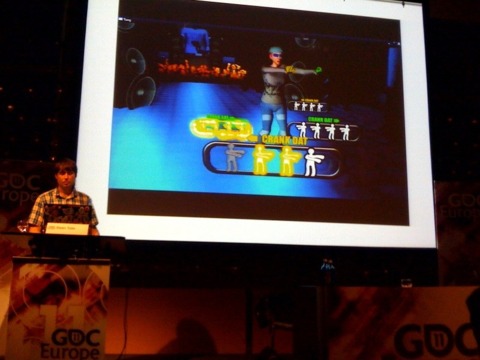Dance Central could have had dedicated hardware - designer
GDC Europe 2011: Lead designer Dean Tate on how the arrival of the Kinect was Dance Central's "deus ex machina moment," early Dance Central prototypes, and Break It Down mode.
Who was there: Dean Tate of Harmonix, lead designer of the Kinect dance game Dance Central
What they said: In his GDC session, Dean Tate said creating a fun, effective tutorial mode was the "greatest design challenge" in Dance Central's development. He discussed how the Harmonix team didn't use the Kinect in the game's formative months but a proprietary hardware system and how "incredibly lucky" they were that Microsoft revealed the Kinect (then Project Natal) when it did. If the Kinect hadn't appeared on the scene, Harmonix would have developed its own dance game hardware, said Tate.

Dance Central spent 17 months in a development, said Tate, with the first five of those given over to creating prototypes. Harmonix examined similarities between existing dance games, based on either dance step mats or motion controllers. These games, designed around detection systems that looked for button presses or accelerometer data, tended toward simple moves, said Tate. The Harmonix designers contrasted these with real dance, in which dancers tend to use mirrors as their "feedback system" and dance instructors for "detection."
Tate showed off a series of prototypes, beginning with a simple Rock Band-style system, with colored icons moving from right to left representing simple dance moves (step forward, jump, spin) to be performed when they crossed a "now" bar on the left-hand side of the screen. This was followed by a prototype with a simple 3D avatar for the player, with feedback laid over the avatar as text comments. Over the course of the prototyping, said Tate, the team wasn't using the Kinect at all; the game's early development period came before Microsoft revealed Project Natal, and the developer was using proprietary detection hardware as a placeholder system.
Abandoned prototype ideas included air trails that were meant to let players read in 3D space what they needed to do ahead of time; Harmonix found these were hard to read in real time. Another prototype idea involved the player tapping "gems" arranged in a circle around the avatar in a 2D plane, allowing colored gems to be used as cues for upcoming moves; this meant sacrificing all but a very simple set of dance moves, and it was also abandoned.
Among the successful ideas that grew out of Dance Central early prototypes were "flavorful" names for dance moves ("scarecrow," "push it down," "walk and hit"); the visual per-beat feedback system on which the finished game is based; and "verb barks," which were monosyllabic verbs ("cross," "back," "hit") used on the beat to tell players what to do. The latter became important in Break It Down, the game's training mode.
Tate called Microsoft's unveiling of Project Natal in 2009 the game's "deus ex machina moment." If the Kinect hadn't appeared on the scene, he said, Harmonix would have produced its own hardware, as in the case of its Rock Band music game franchise. "I think that what would have happened is that Harmonix, as it has done before, would have developed its own hardware solution," he said.
On the topic of Dance Central's learning mode, Tate said that the problem with "nonplayful" traditional tutorial modes is that they "don't lavish attention on presentational flair" and don't offer "gamelike incentives." In Break It Down, Harmonix set about creating a good-looking training mode that was playful and well presented in itself. It brought Harmonix sound designer Arthur Inasi on board as the tutorial's encouraging narrator, whose voice "makes players want to impress him, so he'll be their friend."
As evidence of Harmonix's success, Tate cited positive critical response on Break It Down, noting that it's unusual for tutorial modes to draw specific praise in reviews. He also said that 20 percent of all songs played in Dance Central are played in Break It Down mode.
Quotes: "I'd say we only got to implement 20 percent of the cool ideas we had for Dance Central 1…I think the coolest feature [Dance Central 2] has is simultaneous multiplayer; something we all wanted in Dance Central 1. We just didn't have the time…I'm glad to see that coming out in Dance Central 2."
Also: "We had the fittest, sexiest QA team" by the end of the play testing, said Tate. "They were ripped…A lot of people got really, really good at dancing."
Takeaway: Dance Central was iterated through several prototypes before entering the full production stage, from along the spectrum between traditional dance games and the experience of real dance. A playful, rewarding tutorial mode was the game's "greatest design challenge." Had the Kinect not come along, Harmonix would have produced its own dance hardware for Dance Central.
Got a news tip or want to contact us directly? Email news@gamespot.com
Join the conversation